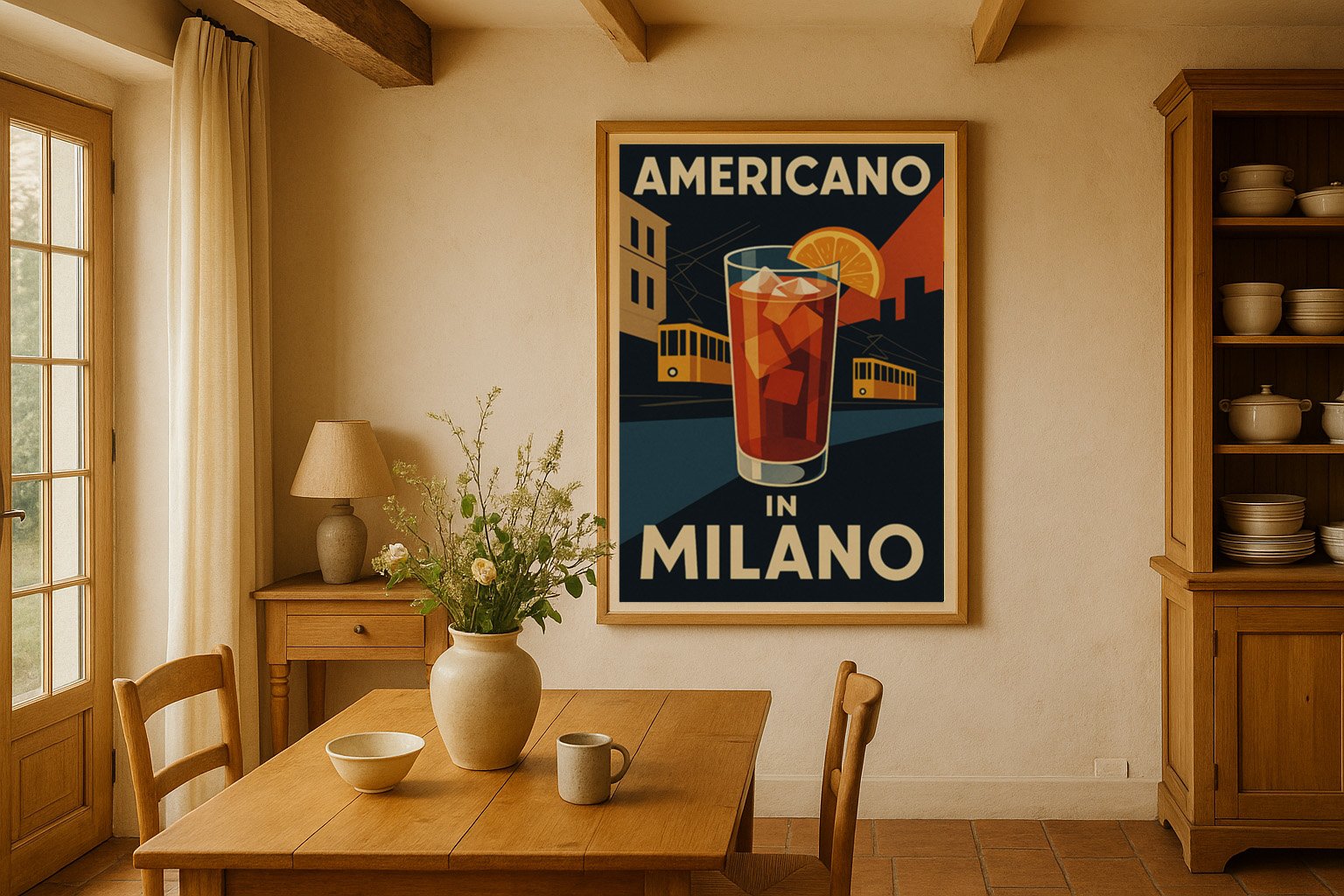
The Art of the Italian Aperitivo: A History of Vintage Cocktail Posters
Italy gave us many things.
Espresso. Ferrari. Fellini.
But one of the greatest?
The aperitivo.
Not just a drink.
A ritual.
A moment that lives between the working day and the night.
Somewhere around 6pm.
Somewhere between the last phone call and the first laugh.
Written by the Vintage Italian Poster Team
The Birth of the Aperitivo: Italy’s Social Spark
To understand vintage cocktail posters, we must first understand aperitivo culture.
Emerging in northern Italy in the 19th century — particularly in cities like Turin and Milan — the aperitivo began as a pre-dinner custom: a small, bitter drink served with olives or crisps to awaken the appetite. But by the early 20th century, this simple practice had evolved into a social institution.
The rise of bitter liqueurs like Campari (1860) and Aperol (1919) gave the aperitivo its signature flavor. But it was urban café culture and Italy’s embrace of graphic design that truly gave it a visual identity.
Enter the Poster: Art Nouveau, Futurism, and Modern Italy
The golden age of Italian poster design began in the late 1800s and flourished into the 1930s. Artists like Leonetto Cappiello, Marcello Dudovich, and Adolfo Hohenstein created bold, elegant designs that fused illustration, typography, and emotional storytelling.
Their work was more than advertising. It was cultural branding. It helped define Italian identity during a time of immense social change.
Key movements that influenced cocktail posters:
Art Nouveau (Stile Liberty): flowing lines, stylized women, nature motifs
Futurism: dynamic angles, speed, energy — perfect for urban café culture
Modernism: clean, minimal compositions that reflected a forward-looking Italy
As aperitivo drinks became symbols of modern life, posters turned them into visual icons.
Campari: The Godfather of Italian Cocktail Advertising
If one brand defined the visual language of aperitivo, it was Campari.
Fortunato Depero, the Italian Futurist, created some of Campari’s most enduring poster art in the 1920s and '30s. His geometric, bold designs weren’t just advertisements — they were avant-garde statements.
Depero’s “Campari Soda” bottle (1932) is still in use today — the first pre-mixed drink sold in a bottle, with a label-free design that became a design object in itself.
Other artists followed, crafting visions of elegance, seduction, and surrealism — always with Campari at the center.
The success of Campari’s poster campaigns helped elevate aperitivo advertising into an art form, influencing generations of designers and drinkers alike.
Aperitivo Posters Between the Wars: Escapism and Glamour
During the interwar years, Italy’s cities were changing. Industrialization brought wealth, movement, and café society. Posters reflected this urban glamour.
You'd find designs showing:
Elegant women in silk dresses holding Martini glasses
Chic couples laughing over Negronis on terraces
Surreal, dreamlike imagery that made cocktails feel timeless
Brands like Martini & Rossi, Cinzano, and Bitter Strega commissioned poster art that played with fantasy and aspiration. Even as political turmoil stirred in the background, the posters offered a seductive escape.
Post-War to La Dolce Vita: A Poster Renaissance
In the post-WWII period, Italy entered an era of prosperity and global fascination — La Dolce Vita. Italian fashion, cinema, and culture surged onto the world stage, and with it, a fresh wave of poster design.
These works embraced:
Photographic elements
Mid-century modern layouts
Bolder color palettes and minimalism
The drinks remained familiar — Campari, Aperol, Cinzano — but the design evolved, becoming sharper, more graphic, more international. Italian cocktail posters now adorned not only cafés and bars, but also airports, restaurants, and department stores across Europe and America.
More Than Advertising: A Visual Language of Leisure
Why do vintage Italian cocktail posters still resonate today?
Because they captured more than just a product. They bottled:
The idea of leisure
The elegance of everyday rituals
The beauty of slowness in a fast-changing world
They made aperitivo a dream — something to aspire to. A few sips of Campari in the right glass, and you too could be part of this painted world.
Today, these posters are collectors' items, museum pieces, and inspiration for contemporary design. Their legacy lives on in minimalist art prints, bar menus, even Instagram aesthetics.
Where to See the Real Thing
If you're ever in Italy (or in major design cities), these archives are worth exploring:
Museo Nazionale Collezione Salce (Treviso) – Italy’s national poster museum
Museo Campari (Sesto San Giovanni, Milan) – Featuring original Depero works
Martini Gallery (Pessione, Turin) – A deep dive into aperitivo history
La Permanente di Milano – Often features retrospectives on poster art
Final Sips: A Toast to Timeless Design
Vintage Italian cocktail posters are more than nostalgic decoration. They are artifacts of a changing Italy, visual echoes of design revolutions, and a celebration of a culture that believes in beauty — even in the small things, like a well-made drink at 6 p.m.
To hang one on your wall is not just to decorate — it’s to time-travel.
Explore The Collection
If you're ready to bring a piece of Italian heritage into your home, browse our full selection of vintage-style Italian posters.
Let your walls do the wandering.


